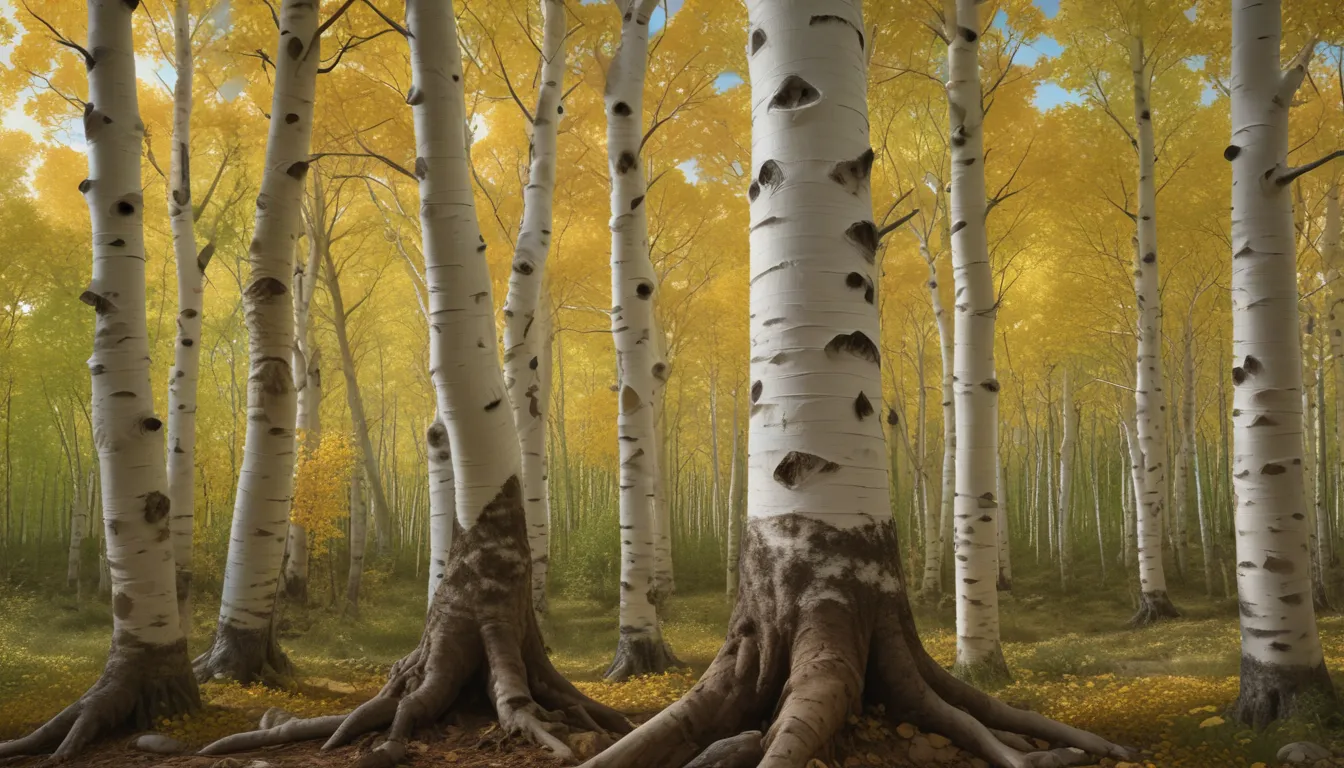The pictures we use in our articles might not show exactly what the words say. We choose these pictures to make you interested in reading more. The pictures work together with the words but don’t take their place. The words still tell you the important facts.
Are you mesmerized by the gentle rustling of quaking aspen leaves, as if they hold secrets that only nature can reveal? Quaking aspen trees, with their ethereal white bark and trembling leaves, are more than just a picturesque sight in the forest. These majestic trees have stories to tell, secrets to share, and mysteries to uncover. Join us on a journey into the enchanting world of quaking aspens as we unveil 23 captivating facts about these fascinating trees. From their unique characteristics to their vital role in ecosystems, quaking aspens are a profound example of nature's beauty and resilience. Get ready to be inspired by the wonders of the quaking aspen tree, where every flutter of leaves carries a tale of its own.
Discovering the Unique Traits of Quaking Aspen Trees
Quaking aspen trees, scientifically known as Populus tremuloides, are renowned for their distinct trembling leaves and vibrant fall colors. Let's delve into what makes these trees truly remarkable:
- Vibrant Fall Colors: Quaking aspens dazzle with hues of yellow, gold, and sometimes red, creating stunning landscapes that captivate the eye.
- Colonial Reproduction: These trees reproduce through root suckers, forming extensive clonal colonies that can cover vast areas and thrive as a single organism.
- Pando: The Giant Organism: One exceptional colony, named Pando, spans over 106 acres in Utah's Fishlake National Forest, making it one of the oldest and heaviest living organisms on Earth.
Unveiling the Ecosystem Contributions of Quaking Aspens
Quaking aspens play a vital role in their ecosystems by supporting diverse wildlife and fostering forest health. Let's explore their ecological significance:
- Food Source for Wildlife: The leaves, bark, and buds of quaking aspens provide essential food for animals like deer, elk, and moose, especially during harsh winter conditions.
- Pioneering Species: These trees quickly colonize open areas after disturbances like fires, stabilizing the soil and creating shade for other plant species to thrive.
- Habitat for Birds and Insects: Quaking aspens attract woodpeckers that nest in their trunks and butterflies that feed on their nectar, fostering biodiversity in the ecosystem.
Unraveling the Growth Patterns and Lifespan of Quaking Aspens
Understanding the growth habits and lifespan of quaking aspens offers insights into their resilience and adaptability to diverse environments. Here's what makes these trees remarkable:
- Rapid Growth: Quaking aspens are among the fastest-growing trees in North America, with the ability to grow up to 2 feet per year, showcasing their vigorous nature.
- Longevity of Colonies: While individual trees live around 50 to 150 years, the vast root systems can survive for thousands of years, continuously sprouting new trunks.
- Versatile Adaptability: From cold northern regions to high mountain altitudes, quaking aspens thrive in a variety of climates, demonstrating their adaptability to different environments.
Embracing Conservation Efforts for Quaking Aspens
Conservation of quaking aspens is crucial for preserving biodiversity and ensuring the health of forest ecosystems. Explore the efforts and challenges in safeguarding these iconic trees:
- Threats of Climate Change: Rising temperatures and altered precipitation patterns pose significant challenges to quaking aspens, impacting their growth and survival.
- Overgrazing Concerns: Livestock and wildlife overgrazing can hinder the regeneration of young aspens, leading to decreased population density and ecosystem imbalances.
- Conservation Initiatives: Conservationists work to protect existing colonies and promote the growth of new ones through controlled burns and grazing management, safeguarding the future of these magnificent trees.
Delving into the Cultural and Historical Significance of Quaking Aspens
Quaking aspens hold symbolic value in various cultures and historical contexts, adding depth to their enchanting presence in nature. Let's explore their cultural and historical significance:
- Traditional Healing Practices: Native American tribes have used quaking aspen bark for medicinal purposes, treating a range of ailments from fevers to wounds with its healing properties.
- Mythical Associations: The unique appearance and rustling leaves of quaking aspens have inspired myths and legends, with some cultures believing they possess protective powers against evil spirits.
- Modern Aesthetic Appreciation: In contemporary times, quaking aspens are celebrated for their visual appeal, often featured in art forms like photography and paintings for their beauty and tranquility.
Unveiling the Scientific Mysteries of Quaking Aspens
The mesmerizing quivering motion of aspen leaves is not merely a visual spectacle; it holds scientific significance and practical benefits for the trees. Let's unravel the science behind the quake:
- Wind Vane Effect: The flat petioles of aspen leaves function as nature's wind vanes, catching even the slightest breeze and causing the characteristic trembling motion.
- Water Conservation: The quaking motion reduces water loss through transpiration on sunny days, helping the trees conserve precious moisture and thrive in diverse environments.
- Natural Pest Control: Research suggests that the leaf trembling may deter leaf-eating insects, providing a natural defense mechanism for quaking aspens against pests.
Exploring the Impact of Climate Change on Quaking Aspens
Quaking aspens serve as indicators of environmental changes, offering valuable insights into the effects of climate change on forest ecosystems. Let's delve into their response to environmental shifts:
- Sensitivity to Environmental Changes: Scientists study quaking aspens as barometers of temperature and moisture variations, monitoring their responses to climate shifts.
- Concerns of Die-Offs: Observations of aspen die-offs in certain regions raise concerns about the future of these trees under global warming scenarios, highlighting the need for proactive conservation measures.
- Future Conservation Strategies: Modeling and predicting the responses of quaking aspens to climate change are critical for developing strategies to protect these trees and maintain the health of forest ecosystems in a changing climate.
Appreciating the Aesthetic Beauty of Quaking Aspens
Beyond their ecological importance, quaking aspens captivate with their visual allure and soothing sounds, enriching outdoor experiences for nature enthusiasts. Let's celebrate the aesthetic charm of these magnificent trees:
- Autumn Splendor: Quaking aspen forests in autumn offer a breathtaking display of golden leaves shimmering in the wind, attracting admirers and photographers to capture their beauty.
- Whispering Leaves: The gentle rustling of aspen leaves, often likened to a soothing whisper or quake, adds a peaceful ambiance to forested areas, creating a serene and enchanting atmosphere for all to enjoy.
Reflecting on the Magnificence of Quaking Aspens
Quaking aspens, with their trembling leaves and striking white bark, symbolize the interconnectedness and resilience of nature. These trees not only enhance the beauty of landscapes but also play vital roles in supporting biodiversity, habitat preservation, and ecosystem stability. With their ability to regenerate and thrive in diverse conditions, quaking aspens embody renewal, growth, and the enduring spirit of nature's interconnected web. Let's cherish and protect these remarkable trees to ensure they continue to inspire and educate future generations with their whispering wonders. As you witness the quivering leaves of quaking aspens, remember that you're witnessing a masterpiece of nature's intricate design. Let's unite in appreciation and stewardship of these awe-inspiring trees for the well-being of our planet and all its inhabitants.
We thrive on providing informative content that inspires and educates our readers. Each fact shared on this platform is a valuable contribution from individuals like you, enriching our knowledge base with diverse insights and information. Our dedicated team of editors upholds the highest standards of accuracy and authenticity in reviewing each submission to ensure credibility and reliability. Explore, learn, and grow with us as we continue to deliver trustworthy and engaging content that celebrates the wonders of nature and the beauty of our world.






